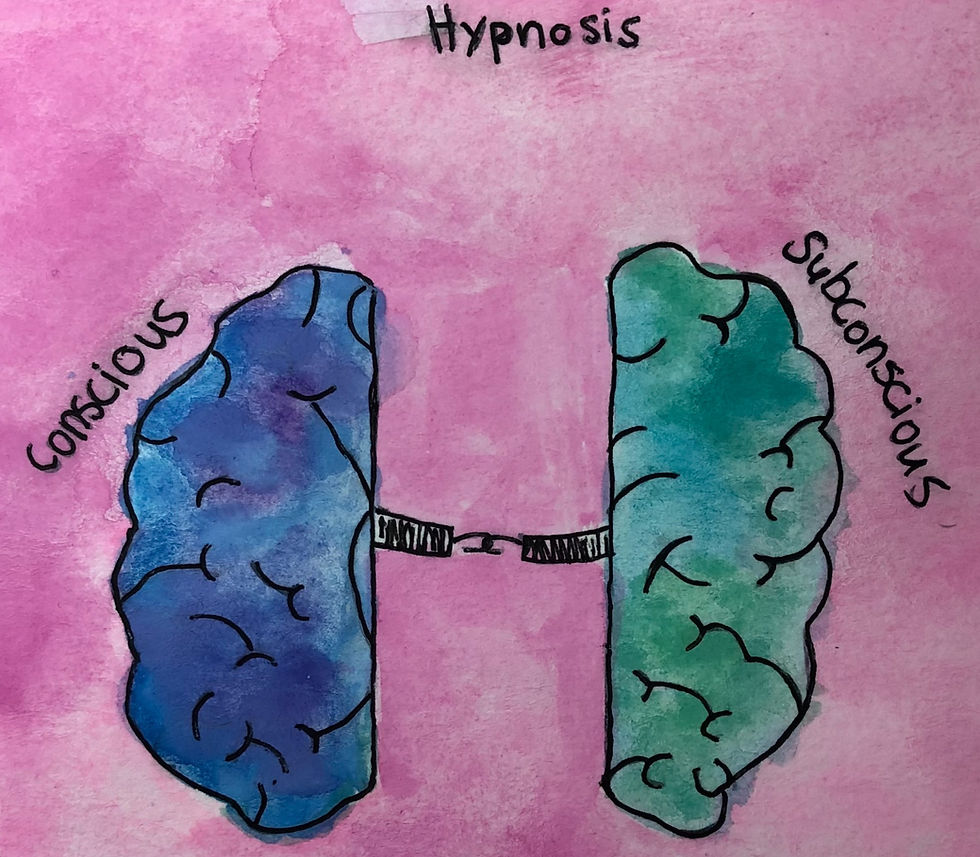Author: Silvia DiPaola
Editors: Shamsia Ahmed
Artist: Susan Wu
The art of hypnosis may strike someone as something only seen in the movies, and one may think of it as simply mind-control. However, hypnosis is quite real and utilized in real life to help those with cognitive issues. It can also be used for the treatment of many conditions including obesity, pain after surgery, anxiety, and stress.

Hypnosis is also referred to as hypnotherapy or hypnotic suggestion, since a person is trying to rectify their actions and/or emotions. Irving Kirsch is a lecturer at Harvard Medical School, and he is researching hypnosis related to weight loss. A pre-existing form of cognitive-behavioral therapy (CBT) combined with hypnosis has been shown to help clients lose significantly more weight than those who just underwent CBT. The former group lost more than 20 pounds in four to six months, while the latter group only lost half that amount. The hypnotized group was also able to keep their weight off in the later months, and the CBT one tended to regain it. Hypnosis was also found to be effective for postoperative pain after surgery, pain associated with labor and delivery, and quitting smoking; a 2007 study of 286 smokers determined that 20% of the people who received hypnosis quit smoking, as compared to 14% who quit after receiving only therapy.
So, how exactly does hypnosis work? It involves opening the barrier between your conscious and subconscious mind so that the latter retains ideas that are more beneficial for you. The process usually involves two stages, the “induction” phase, and the “suggestion” phase. During induction, the person undergoing hypnosis is told to relax, calm their mind, and focus on the therapist’s voice. The goal is to make the person more open to suggestions that will be brought up in the second stage. Contrary to what television might portray, you do not lose control over your behavior , lose consciousness, or forget what is happening during hypnosis. During the suggestion phase, the person is talked through hypothetical scenarios to help him/her address unwanted emotions and behaviors. The kinds of scenarios used depend on what the person is undergoing hypnosis for. The overarching plan for successful hypnosis is for the person to set aside their conscious judgments and reactions, and to enter a deeper state of concentration. The result should be that the person will be able to have more control over their thoughts and perceptions, thus easing the reason why he/she wanted to get hypnosis in the first place. Through studies done, it has been found that hypnosis acts on multiple regions in the brain, sometimes even those related to pain perception and regulation. It may also quiet parts of the brain involved in sensory processing and emotional response.

However, hypnosis is not always effective for everyone. Len Milling, a professor of psychology at the University of Hartford, has stated that 20% of subjects don't show a large response, 20% don't respond much at all, and the other 50-60% of clients are somewhere in the middle. Children in general tend to be more affected by hypnosis than adults. The effectiveness of hypnosis largely depends on how deep you are in the proper state. The deeper you are into the state of hypnosis, the more effective it seems to be. This process should also not be utilized for those with severe mental illness, as it may exacerbate their condition. Undesired side effects of hypnosis are rare but are still quite plausible; these may include headache, creation of false memories, drowsiness, or dizziness. Even so, hypnosis under the guidance of a certified therapist is generally considered quite safe.
If you wanted to, you could hypnotize yourself! Self-hypnosis is indeed possible, although some may be averse to it due to fears of meddling in their mind. A quiet place, an open attitude, and some practice are required to successfully self-hypnotize and erase unwanted and harmful behaviors. It is also fairly easy to learn, and it only takes a few minutes out of one’s day.
Some may find hypnosis to be better than medication, as it is natural and can be ended at any time. It does not involve medical procedures, drugs, and perfect conditions you must achieve. It is simply calming your mind and adapting it to how you want it to work. However, some may be terrified by the idea of “going under” and possibly losing control of your mind and your emotions, which is not the case. Regardless of the public stance, hypnosis is a fascinating form of psychological therapy that has many practical uses that many might find helpful if one is willing to look back and forth at a swinging watch or metronome!
Citations:
Flaxington, Beverly D. “The Healing Practice of Self-Hypnosis.” Psychology Today, Sussex Publishers, 21 Oct. 2019, www.psychologytoday.com/us/blog/understand-other- people/201910/the-healing-practice-self-hypnosis.
Heid, Markham. “Is Hypnosis Real? Here's What Science Says.” Time, Time, 4 Sept. 2018, time.com/5380312/is-hypnosis-real-science/.“Hypnosis.” Psychology Today, Sussex
Publishers, www.psychologytoday.com/us/basics/hypnosis.
Mayo Clinic Staff. “Hypnosis.” Mayo Clinic, Mayo Foundation for Medical Education and
Research, 1 Nov. 2018, www.mayoclinic.org/tests-procedures/hypnosis/about/pac-
20394405.
Comments